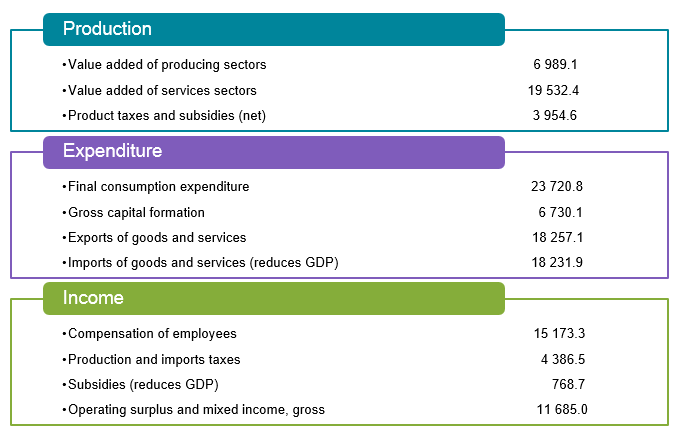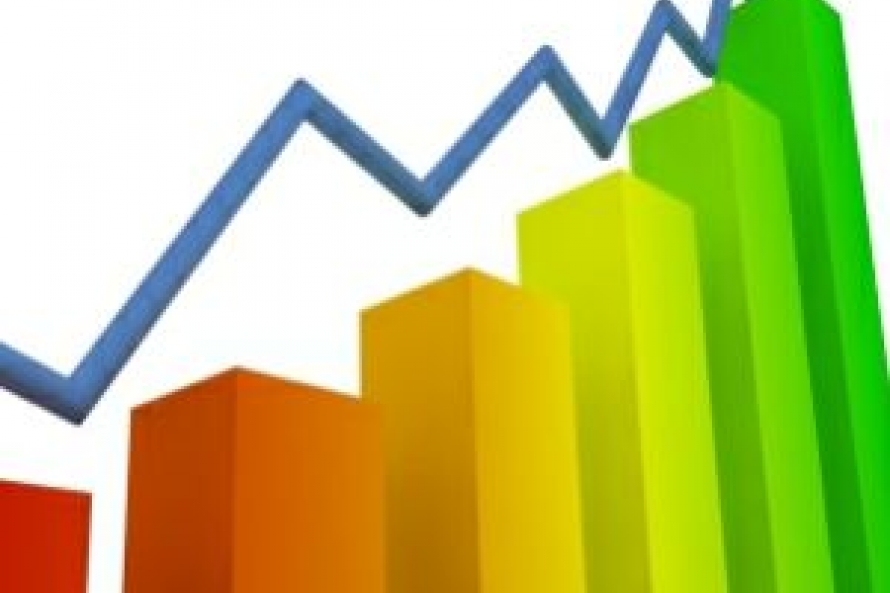In 2019, GDP at current prices amounted to EUR 30.5 billion.
Compared to the 3rd quarter, in the 4th quarter of 2019 GDP at constant prices grew by just 0.1 % (according to seasonally and calendar adjusted data), a slight revision downwards on earlier flash estimates, as reported by LSM.
The growth rate was much more modest than in recent years. Annual GDP growth was 4.8 % in 2018 and 4.5 % in 2017.
In 2019, increases were registered in agriculture, forestry and fishing – of 12.8 %, which was mainly affected by production output rise in crop and livestock production – of 23.8 %, forestry and logging – of 5.9 %, but a decrease was recorded in fishery. In 2019, weather conditions were very favourable for the development of crop production sector, which ensured highest harvested production of grain in Latvia's history (3.2 million tonnes) and rise of crop production over the previous year of 46.4 %. Volume of livestock production fell by 1.1 % (prices of livestock production have risen by 3.9 % over a year).

Manufacturing went up by 2.1 % (a rise was observed in ten out of 22 sectors). In the sector having the largest share in manufacturing – manufacture of wood and of products of wood – production output remained at the level of the previous year. Rise was recorded in manufacture of fabricated metal products (of 13.6 %), manufacture of computer, electronic and optical products (9.3 %), manufacture of electrical equipment (16.0 %), printing and reproduction of recorded media (7.5 %). But reduction was observed in manufacture of food products (of 0.8 %), manufacture of other non-metallic mineral products (2.1 %) and manufacture of furniture (2.8 %).
In electricity, gas, steam and air conditioning supply manufacturing volume fell by 4.4 %, of which in production and distribution of electricity – by 3.2 % and in steam and air conditioning supply there was a decrease of 10.3 %.
Construction production volume rose by 2.9 %. Over the year, construction of buildings grew by 7.8 %, civil engineering – by 1.0 %, and specialised construction activities by 0.2 %.
In 2019, retail trade increased by 2.4 %, of which retail trade in food products – by 1.1 %, but trade in non-food products – by 4.2 %. Wholesale trade, retail trade and repair of motor vehicles and motorcycles rose by 6.2 %, but wholesale – by 5.3 %.
In transport and storage sector decrease of 4.0 % was promoted by drop in freight transport by 6.0 %, fall in warehousing and support activities for transportation by 7.5 %, rise in passenger traffic by 7.7 %, increase in postal and courier activities by 17.8 %.
Accommodation and catering services grew by 8.0 %, of which accommodation – by 1.2 %, catering – by 11.2 %.
Information and communication services grew by 2.0 %, including rise of 9.1 % in computer programming and consulting. Information and communication services decreased by 0.3 %, and telecommunication services – by 5.8 %.
In 2019, financial and insurance activities fell by 8.8 %, which was mainly because of the decline in financial service activities of 10.9 % and drop in activities auxiliary to financial services and insurance activities of 17.8 %.
Commenting on the figures, Swedbank said:
"Export growth in 2019 halved with respect to the year before. Foreign trade flows were dragged down by softening external demand, as well as challenges faced by one of the largest Latvian export industries – wood manufacturing (e.g., weaker demand, increased competition, oversupply of wood products due to the spruce bark beetle infestation in Europe). The record harvests of last year and the resulting increased exports of cereals supported overall export growth. Due to weaker investment activity, imports slowed even more than exports, somewhat flattering the overall growth.
"Private consumption slowed but was more resilient than other expenditure components. It was supported by relatively high household confidence, moderate inflation, and a strong labour market, which has seen rising wages and falling unemployment. Private consumption is set to remain a driving force of GDP growth this year as well.''
It all adds up to a rather uncertain picture, Swedbank concluded, saying: ''In January, when external uncertainty seemed to be fading, we updated our forecast for this year, expecting a growth of 2.2% - same as in 2019. However, since then a new set of worries has emerged in the global environment. Recently it has become clear that the coronavirus COVID-19 is spreading outside of China, which means that the impact is likely to be more severe and protracted than appeared previously. A global and a European slowdown is likely to have an impact on Latvia’s small and open economy both via the demand channel, as well as through supply-chain links. However, the extent of this impact is extremely difficult to determine at the current juncture."






























